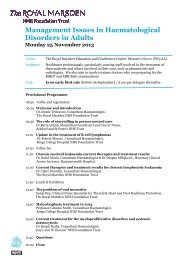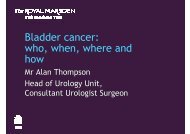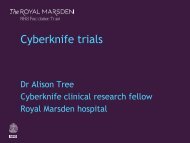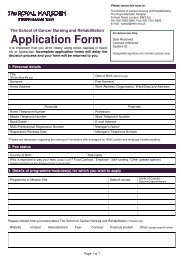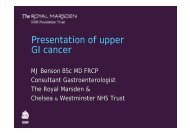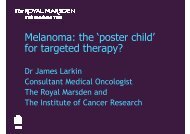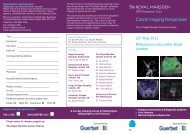Quality Account 2010/11 - Royal Marsden Hospital
Quality Account 2010/11 - Royal Marsden Hospital
Quality Account 2010/11 - Royal Marsden Hospital
You also want an ePaper? Increase the reach of your titles
YUMPU automatically turns print PDFs into web optimized ePapers that Google loves.
The <strong>Royal</strong> <strong>Marsden</strong> NHS Foundation Trust<br />
Further progression of the<br />
survivorship programme<br />
It is recognised that the Trust has started to<br />
take forward work to support the survivorship<br />
model of care recognising the number of<br />
patients who live successfully following<br />
cancer treatment. Both the commissioners and<br />
Trust are keen to see the Trust progress the<br />
initiative of implementing carefully planned<br />
discharge of patents to open access follow up.<br />
NHS South West London are satisfied that the<br />
<strong>Quality</strong> <strong>Account</strong> <strong>2010</strong>/<strong>11</strong> has provided assurance<br />
on the performance of The <strong>Royal</strong> <strong>Marsden</strong><br />
Foundation Trust and that the accuracy of data is<br />
being validated through the external audit process.<br />
Dr Tony Brzezicki<br />
Chair of Clinical <strong>Quality</strong> Review Group<br />
Statement from the London Borough of<br />
Sutton Overview and Scrutiny Committee<br />
Response to The <strong>Royal</strong> <strong>Marsden</strong> NHS<br />
Foundation Trust <strong>Quality</strong> <strong>Account</strong>s <strong>2010</strong>/<strong>11</strong><br />
We welcome the receipt of the Annual Report and<br />
<strong>Account</strong>s <strong>2010</strong>/<strong>11</strong> for The <strong>Royal</strong> <strong>Marsden</strong> NHS<br />
Foundation Trust. However, we would appreciate<br />
having more time to respond to such a large<br />
document. We would also value the opportunity<br />
for more ongoing engagement throughout the<br />
year rather than receive the report right at the end<br />
in final draft form. For example we would have<br />
welcomed the opportunity to attend your listening<br />
event on the 26th of March 20<strong>11</strong>.<br />
General Feedback<br />
The document provides a very useful introduction<br />
and context to help people understand the<br />
objectives, recent changes and challenges.<br />
However, an executive summary would be useful<br />
as it will allow people an overview of the report<br />
and enable them to identify areas of interest<br />
without having to immediately go through a 125<br />
page document. The text is also small and may be<br />
difficult to read.<br />
Finally, for a document aimed at the public<br />
(amongst others) the language could be clearer<br />
(e.g. use of medical terms) and graphs need<br />
full explanation.<br />
Specific Feedback<br />
P4 – no indication of total number of respondents<br />
is given with percentages this would improve our<br />
ability to engage and analyse. Similarly, where<br />
relevant, non-response rates by question would<br />
also be useful to help understand the data. It would<br />
also be helpful (again where relevant) to see data<br />
in context of the national picture to demonstrate<br />
relative performance.<br />
P6 – Priority by priority analysis. Whilst generally<br />
easy to engage with there is some use of jargon in<br />
this section which is not explained, this reduces<br />
the ability of the layman to engage with the report,<br />
(e.g. p14: ‘There is also international evidence to<br />
show that planned protocolised care pathways<br />
for example using the Enhanced Recovery<br />
Programme (ERP), increase the quality of care and<br />
reduce the length of time spent unnecessarily in<br />
hospital’).<br />
P7 – In the sections on hospital acquired infections<br />
we welcome your commitment to meeting national<br />
targets but ultimately aiming to eliminate cases to<br />
nil.<br />
P10 – The graph in this section and others gives<br />
figures for very low, low, moderate and high and<br />
does not provide sufficient explanation of what<br />
these categories mean or how they differ.<br />
P19 – The report says that patient feedback is<br />
sought and acted upon through the Picker system.<br />
This information is then used to design and<br />
implement improvement plans. In addition to this it<br />
might be good where possible to involve patients in<br />
generating ideas for these improvement plans.<br />
P21 – The free text comments are illuminating,<br />
however, it would also be useful to see some<br />
typical complaints as well as compliments.<br />
P37 – The information on key metrics could be<br />
made easier to understand if the red, amber, green<br />
system was applied (although it is understood that<br />
this may not be possible due to national guidance).<br />
In conclusion we are please to see the achievement<br />
of an ‘excellent’ in the National Patient Safety<br />
Agency Annual Patient Environment Action Team<br />
(PEAT) and also welcome the completion of the<br />
new Centre for Children and Young People.<br />
Cllr Mary Burstow<br />
Chair<br />
Cllr Jennifer Campbell-Klomps<br />
Vice Chair<br />
42






